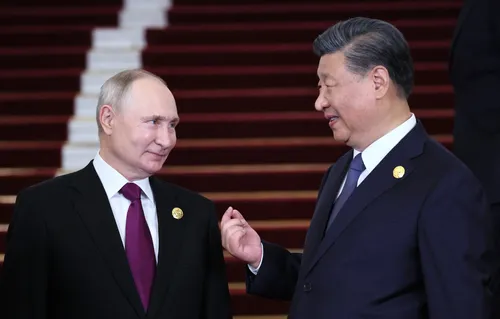
On a recent visit to China, Russian First Deputy Prime Minister Andrei Belousov stated that this year the use of the Russian ruble and Chinese yuan in trade between the two countries has already reached 95%.
At the same time, from January to October, 68% of all Russian trade was carried out in the two countries’ currencies, according to Russian Minister of Economic Development Maksim Reshetnikov.
The yuan has also been used by Russia in commercial transactions with Mongolia, the Philippines, Malaysia, the United Arab Emirates, Thailand, Japan, Tajikistan and Singapore.
The debate about the need for de-dollarization of the economies of the Global South is not new, but 2023 will go down in history as the year in which this process accelerated.
History of sanctions
Russia has already imposed more than 17,000 sanctions since the start of the so-called Special Military Operation in the eastern region of Ukraine in February 2022, according to information recently released by Russian Foreign Minister Sergei Lavrov.
The map of the Global North is practically that of the countries that have sanctioned Russia: the United States, Canada, the United Kingdom, the European Union (and candidates to join the bloc), Switzerland, South Korea, Australia and Japan, and some exceptions such as Singapore.
Sanctions reached historic levels in this new wave. According to US President Joe Biden himself, they were designed to have a long-term impact on Russia and “surpass anything we’ve ever done.”
The first wave of sanctions was imposed in 2014, following the crisis in Ukraine that led to a coup d’état against President Viktor Yanukovych, and which included the involvement of the United States.
Measures against Russia began to be implemented when the country decided to reunify with Crimea, whose inhabitants refused to recognize the new government resulting from the coup.
“From 2014 to 2022, Russia simultaneously pursued de-dollarization and euroization. During this period, the European Union became Russia’s main trading partner, leading to a shift in the main transaction currency from the US dollar to the euro,” he explains Xu Poling, the director of the Department of Russian Economy at the Chinese Academy of Social Sciences.
With the European Union intensifying sanctions in 2022, banning any transactions with the Russian Central Bank, as well as the sale, supply, transfer and export of euro-denominated banknotes to Russia, more than half of Russia’s reserves have been captured, equating to around 300 billion dollars. The West even began to openly discuss the definitive theft of this amount.
In its 2022 report, the Central Bank of Russia stated that “following the enactment of sanctions by hostile states, their currencies have become ‘toxic’ for Russian economic agents.” “An increase in agreements with friendly countries in national currencies has become critical to guarantee and develop foreign trade”, concluded the institution’s report.
According to Xu Poling, from 2022 until now trade between Russia and Europe has fallen by 70% and between Russia and Asia an increase of 70%.
Imports from Asia, especially mainland China and Hong Kong, now constitute 40% of total Russian imports. Approximately 60% of Russia’s sovereign wealth fund is in RMB assets, and 40% of its foreign exchange reserves are also in RMB assets.
Russia’s share of European Union imports, until September this year, fell to 2%, according to Eurostat, the bloc’s statistical service. In February 2022, the figure was almost five times higher, 9.5%.
Check out the video report:
Boomerang effect of sanctions
“The first time I heard a serious debate about de-dollarization, about the need to place it at a very high level of geopolitical importance, was in 2014. Some senior officials in China described de-dollarization as one of the most important geopolitical lessons, mainly because of Iran,” says Zhang Xin, deputy director of the Russian Studies Center at East China Normal University (UNLC),
After the sanctions on Russia, continues Xin, many developing countries became concerned that their own assets and financial stability would begin to be subject to this excessive use of the dollar as a geopolitical financial weapon.
At the end of last year, the Organization of Petroleum Exporting Countries (OPEC), under the leadership of Saudi Arabia, decided to make the biggest cut in supply since 2020, by around 2 million barrels. The Biden administration threatened Saudi Arabia over the decision, saying there would be “consequences” for the country.
India used rupees, for the first time in history, to buy one million barrels of oil from the United Arab Emirates in August this year. Both Saudis and Emiratis will become part of BRICS+ in January 2024.
::::: In a historic move, Brics expands and adds six countries from the Middle East, Africa and Latin America :::::
In November, the European Commission presented the twelfth sanctions package against Russia and expects its member countries to approve it in mid-December.
The Russian agency Ria Novosti, based on data from Eurostat, recently showed that from February 2022 until September this year, the European Union started paying, on average, double what it paid before for liquefied natural gas from the USA.
According to the calculation, the bloc would have paid more than 52 billion euros more for fuel, compared to the price the US charged in 2021.
China-Russia trade record in 2023
Trade between Russia and China has just broken a record of more than 200 billion dollars, bringing forward a target that had been set to be reached in 2024.
The figure from January to November was more than the equivalent of 218 billion dollars, which represents an increase of 26.7% compared to the same period in 2022. The annual result must still exceed the objective of US$ 220 billion predicted by Russia a few months ago.
The growth in the bilateral commercial relationship brought a change in the composition of transactions, with Chinese companies occupying the space left by European and Japanese companies.
For Zhan Xin, it is important to highlight not only the total volume, but also the content and structure of trade. “If you look at the segregated trade data, China is exporting more and more hardware equipment, electronics, machinery and heavy trucks, as well as automobiles to Russia. This is something that has never been part of the historical trade pattern between the two countries “, he explains.
Economist Xu Poling considers that this artificial restructuring of global industrial and supply chains incurs important costs and that the recovery process could take a long time, at least five years, and potentially up to ten years.
“During this period, most countries may struggle to achieve growth and instead [terá que] bear the costs of rebuilding safe industrial chains. I think this whole process is regrettable for all the countries involved”, expresses Poling.
Evolution of Brics may favor de-dollarization movement
Both in his state visit to China in April this year and at the XV BRICS Summit in August in South Africa, President Lula defended the use of a payment system based on local currencies without the need to use the dollar.
::::: In China, Lula says that NBD could become the ‘bank of the Global South’ and criticizes dollar hegemony :::::
At the next Brics summit, which should take place in October next year in Kazan, under the presidency of Russia, the Economy ministers and central bank presidents are expected to deliver a report on the viability of the initiative.
“The combination of large industrial economies, China in particular, a sector of the main energy-rich countries and the main countries of the developing world, can change the dynamics that have been the economic and political basis of the power of the US dollar, the so-called petrodollar , since 1970,” says Zhang Xin.
At the BRICS summit in Johannesburg, the Russian president was the first and only one to use the word “dedollarization”. “A balanced and irreversible process of de-dollarization of our economic ties has been gaining strength, with efforts undertaken to develop efficient mechanisms for mutual payments, as well as monetary and financial control,” said Vladimir Putin.
Dedollarization will not be completed quickly, considers Poling. “On the one hand, new options must emerge and, on the other hand, the fact that the US can reach agreements with other countries, providing more facilities and guarantees, will also have an impact on the de-dollarization process.”
However, the expert states that with the politicization of the dollar and its use as a weapon, the de-dollarization process is an inevitable trend.
Editing: Rodrigo Gomes
Source: www.brasildefato.com.br

